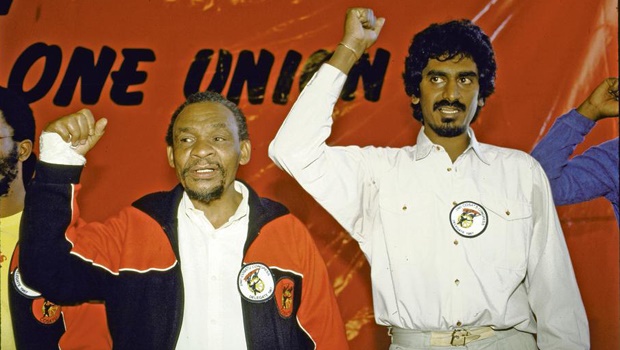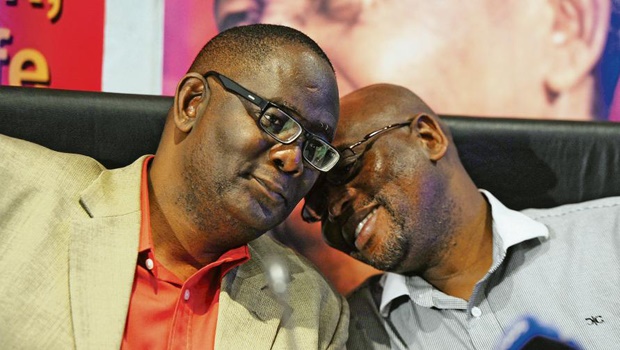A new book argues the labour federation faces a crisis of relevance, strength and survival. Its most fatal wounds, the authors suggest, are self-inflicted.
Today when delegates arrive in Johannesburg for Cosatu’s congress, the labour federation will be facing the greatest crisis in its 30-year history.
It is not simply another crisis that can be manoeuvred out of with a couple of resolutions and a 10-point plan. The dilemma facing the continent’s most powerful trade union movement is a crisis of existence, the type that could see it fading into irrelevance in the not-so-distant future. It is a crisis of survival, strength and relevance.
It is this crisis that an authoritative new book, titled Cosatu in Crisis: The Fragmentation of an African Trade Union Federation, grapples with. Edited by academics Vishwas Satgar and Roger Southall, Cosatu in Crisis consists of essays and papers by 13 authorities in the field of unionism. The topics cover everything from the political rupture in the federation to ideological drift and the socioeconomic challenges facing the unions.
The picture painted in the book is a far cry from the spirit of December 5 1985, when Cosatu’s first president, Elijah Barayi, and general secretary Jay Naidoo were carried on to the Kings Park Stadium pitch in Durban on the shoulders of jubilant workers. On that day, they were celebrating a unity that had taken about five years of negotiating ideological, industry, political, class and personal obstacles. As this was at the height of apartheid, they were also celebrating the birth of a new weapon in the struggle against the National Party government.
Over the next few days, Cosatu delegates will reflect on the past three decades and their leaders will outline plans for the 30-year celebrations. But as the book points out – and they themselves are aware – there is little cause for celebration. Cosatu leader Sdumo Dlamini and former leader Zwelinzima Vavi – Barayi and Naidoo’s successors, respectively – openly hate each other, and the federation is being battered by myriad global forces.
In a forlorn foreword to the book, Vavi pooh-poohs the effect of personal differences as a major factor in Cosatu’s demise, instead pointing to a deliberate plot by the democratic state’s ruling elite to weaken mass formations that used to be the backbone of the struggle for this very democracy.
He says “all of the country’s mass formations have been blunted as instruments of popular power”. He points to the weakening youth and women’s formations and the collapsing of civic organisations’ rural movements as precursors of what is happening to Cosatu.
“The last powerful weapon in the hands of the working class is the democratic trade union movement, which is now being targeted for co-option to serve the agenda of powerful interests. While workers thought they were struggling for the soul of the ANC, a hidden agenda was being hatched by forces hostile to the working class to capture the soul of Cosatu,” writes Vavi.
Although the big bang moment in what is considered the coming death of Cosatu was the year leading up to the expulsions of Vavi and metalworkers’ union Numsa – and their aftermath – the book’s contributors paint a much bigger picture.
Ideology, class and independence
There is a view in some circles that the ideological differences that bedevilled the pre-1985 unity talks were never fully resolved.
These could roughly be along so-called “workerist” and “charterist” lines. The workerists, the backbone of which was the metalworkers’ union, felt strongly that trade unions should retain their independence from the liberation movements.
As the name suggests, the charterists believed that the trade union movement should adopt the Freedom Charter and align with the exiled ANC. In the heady days of struggle, the charterists won the day and unity was achieved.
One of the book’s essayists writes: “There are strong grounds for arguing that ideological differences, suppressed or contained for the best part of two decades of democracy, are now reappearing.”
Fast-forward to the democratic era and there was a strong push for the trade union movement to “free” itself to be able to openly differ with the policies of the ANC and the government.
This view that unions exercise democracy independently of the ANC lay at the heart of Cosatu being one of the drivers of the putsch against then president Thabo Mbeki. But once Mbeki was gone, some elements sidled up to the new order, putting the unity of the tripartite alliance before the unity of the federation. This created new fault lines within the union movement.
With state workers being in more comfortable employment and not battered by rough economic conditions, public sector unions took a more sympathetic line towards government and the ANC.
Inequality and deindustrialisation
The decline of South Africa’s industrial production and the rise of the services sector shook up the labour market in ways that trade union leaders did not foresee, and it has disturbed their power. The drop in employment levels hit trade union membership hard. It encouraged the casualisation of labour and the employment of temporary staff, thus making trade union recruitment extremely difficult. This created its own tensions among the working class, as permanent workers were likely to be unionised and more jealous of their rights while the temporary and casualised workers were simply grateful to have jobs.
“Often, these two segments of the labour market are in conflict, since permanent workers fear for their jobs and feel threatened by workers who take on flexible contracts,” write a pair of authors.
Globalisation, the erosion of mainstream employment and the changing workplace are damaging Cosatu’s ability to fight its biggest struggle – South Africa’s unacceptably high inequality.
Social distance
In the post-1994 era, what is viewed as a form of social distance has developed between leadership and workers. Shop stewards see their role as a ladder to managerial or union leadership posts, while leaders see their role as a path to ANC deployment in government and the legislatures.
Summing up the contributions of the various authors, Satgar and Southall acknowledge that Cosatu is among the victims of global forces battering labour, but they add that it has also dug its own grave. A bullet in the foot, they say, “is the self-defeating embrace of authoritarian populism centred on Jacob Zuma and its failure to grasp the imperative of working class unity”.
What kind of Cosatu animal will emerge from this crisis might be beyond the intervention of the delegates at this week’s congress. But the horse has probably bolted.
Cosatu in Crisis is published by KMM Review Publishing
Recommended retail price: R249.95




 Publications
Publications
 Partners
Partners











